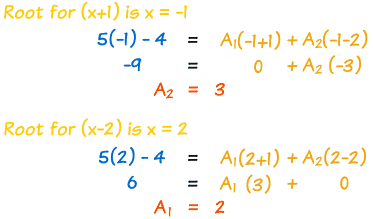Intro: Partial fractions
- Instead of simplifying two fractions into one, we want to break them up here.
- Degree is the highest power of x in the set
- Proper fractions = Numerator < Denominator
- Improper fractions = Numerator > Denominator
- Proper algebraic fractions = Degree of numerator < Degree of Denominator
- Improper algebraic fractions = Degree of numerator > Degree of Denominator
Simplifying:
Previously we have been taught how to simplify two fractions into one. (/ sign = border between numerator and denominator)
For example:
8/x+9 + 2/x-3
1st step: Change denominator to the same thing, to do this multiple both numerator and denominator by the denominator in the fraction it is added or subtracted to.
8x-24/(x+9)(x-3) + 2x+18/(x+9)(x-3)
2nd step: Add or subtract the fractions together, by adding the numerators into one fraction.
10x-6/(x+9)(x-3)
This is the answer if we simplify.
Decomposition:
Now lets try something new using the same equation from example of simplifying.
10x-6/(x+9)(x-3)
1st step: Separate into two different fractions with a variable as numerator.
A1/x+9 + A2/x-3
2nd step: Multiply through the bottom to eliminate denominator
A1(x-3) + A2(x+9)
3rd step: Bring the 10x+6 in
10x+6 = A1(x-3) + A2(x+9)
4th step: Find the roots, so that we can eliminate 1 variable and find the other
Root for x-3 is 3
Root for x+9 is -9
5th step: Sub in and solve
Let x be 3
10(3) + 6 = A1(3-3) + A2(3+9)
36 = A2(12)
A2 = 3
Let x be -9
10(-9) + 6 = A1(-9-3) + 3(-9+9)
-96 = A1(-12)
A1 = 8
Hence, A1 = 8 and A2 = 3
6th step: Express as partial fraction
8/x+9 + 3/x-3
































